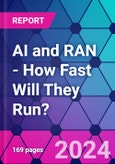Is AI present at the cutting edge of the RAN? The answer is a resounding yes. AI is present in the RAN now. This is the present tense. The fact is, that AI and RAN have been waiting to embrace each other for several years. Their stars were not favorably aligned thus far. What changed then?
For starters, RAN started getting disaggregated. From the monolithic structure impervious to ‘outside’ interventions of yesteryears, the present-day RAN likes to present itself as a loosely-coupled, nimble, and welcoming outfit.
Is it really like that? Well, the jury is out on that. It cannot be denied, however, that it is trying to get there. Naysayers may argue that there are certain inherent contradictions in this journey. Can’t deny that. The RAN ‘establishment’ is suspecting of outsiders. But hey, let’s park this worry for a bit, and look at the brighter side.
The entry of AI in the RAN architecture can surely be counted on the brighter side of things. The publisher highlights the contours of this foray and puts numbers on the addressable market size for AI in RAN.
Highlights
As the report features a thorough breakdown of the market by application, region and telephony generations, it provides telling quantitative insights.
- The addressable market for AI in RAN will grow by an impressive 45% annually during 2023-2028
- The addressable market for AI in 5G RAN will grow faster than earlier telephony generations
- The APAC region will be the largest market for AI in RAN caching applications
Scope
The chapter “AI/ML/DL -Key Concepts Explainer” lays down the basic ground for what constitutes AI, ML and DL. While these concepts are covered extensively in contemporary times, it is important to unambiguously define them to put into perspective, their role in the cellular mobile network architecture. However, the crux of the chapter is the explanation of the several use cases that this report sizes and forecasts the market for. This chapter enunciates in appropriate detail the applications of AI, ML and DL in the operations of 4G and 5G cores.
The chapter “Virtualization of the RAN” places virtualization in the realms of the RAN network function. In the context of AI, if there is any development that has made RAN more ‘amenable’ to AI adoption, it is its virtualization. Initiatives such as OpenRAN are a direct result of the ground laid by SDN and NFV technologies. The chapter traces the evolution of the RAN and its progressive virtualization
The chapter “End-applications for AI in the RAN” details the import of AI to the RAN. It dives into the role played by O-RAN in providing a pathway for deeper integration with AI. The chapter then includes the principal RAN use cases: traffic optimization, caching, energy management, and coding; where AI is providing or likely to provide seminal contributions.
The chapter “Vendor Initiatives for AI in the RAN” identifies, covers, and analyzes key vendors and their solutions related to AI in the RAN. More importantly, the chapter uncovers the seminal impact that AI is engineering on the RAN vendor landscape.
The chapter “Telco Initiatives for AI in the RAN” details the approaches and initiatives of leading telcos in the context of AI in the RAN. It should be remembered that it was the telcos that championed the NFV movement. A fallout of this movement is the gradual induction of AI in the RAN architecture. The RIC through the O-RAN initiative has been a major step in that initiative. This chapter chronicles the telco initiatives and their outcomes.
The chapter “Quantitative Analysis and Forecasts” presents the quantitative forecast of the market for AI in cellular mobile RANs. The market is broken down based on several different criteria; most notably the applications themselves. Other sub-criteria include mobile telephony generations and geographical regions.
Table of Contents
Companies Mentioned
- Aira
- AirHop
- Aspire
- AT&T Inc
- Axiata Group Berhad
- Bharti Airtel
- Capgemini
- China Mobile
- China Telecom
- China Unicom
- Cisco
- CK Hutchison Holdings
- Cohere
- DeepSig OmniSig
- Deutsche Telekom
- Ericsson
- Etisalat
- Fujitsu
- Globe Telecom Inc
- HCL
- Huawei
- Juniper
- Mavenir
- MTN Group
- Net AI
- Nokia
- NTT DoCoMo
- Nvidia
- Ooredoo
- Opanga
- Orange
- P.I. Works
- PLDT Inc
- Qualcomm RIC
- Rakuten Mobile
- Reliance Jio
- Rimedo
- Samsung
- Saudi Telecom Company
- Singtel
- SK Telecom
- Softbank
- T-Mobile US
- Telefonica
- Telenor
- Telkomsel
- Verizon
- Viettel Group
- VMware
- Vodafone
- ZTE








